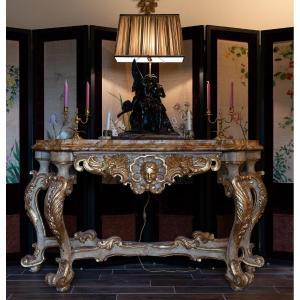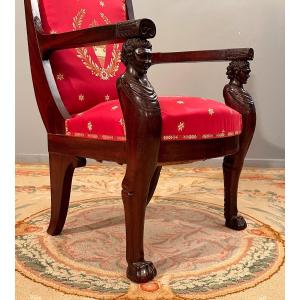François Honoré Jacob (1770-1841) - Four large Empire-period mahogany armchairs circa 1810
Stamped Salon furniture by Jacob D Rue Meslée, composed of four magnificent, wide, and rare mahogany and mahogany veneered armchairs, with simply molded flat backs, the armrests ending in a gilded palmette.
Our armchairs stand on double-baluster front legs or Jacob's feet, with saber-shaped back legs.
A splendid upholstery job has been undertaken, with picture backs and cushioned seats in a beautiful yellow fabric.
Very fine French Empire period work stamped Jacob D Rue Meslée for François Honoré Jacob (1170-1841).
Sizes: H 38.58 Inches. - W 24.80 Inches. - D 21.25 Inches.
In very good condition, varnished in our workshops, new old-fashioned upholstery.
Biography:
François-Honoré-Georges Jacob-Desmalter (1770-1841) was the most successful Parisian cabinetmaker between 1796 and 1825.
Son of Georges Jacob, who designed the Louis XVI and Directoire styles, he joined forces in 1796 with his brother Georges Jacob Fils to create Jacob Frères on Rue Meslée. His father had benefited from commissions from the royal family under the Ancien Régime, and the two brothers took on commissions from the imperial family.
Using sketches by painter Jacques-Louis David and ornamentalists Percier and Fontaine, the brothers created furniture inspired by Greco-Roman antiquity to launch the Empire style.
Their style is characterized by high-quality design, clean lines, original shapes, and the use of chased gilded bronzes (created by Pierre-Philippe Thomire). For joinery, he used mahogany, gilded wood, and lacquered wood, with occasional inlays of ebony and indigenous woods such as maple and yew.
For Empress Josephine, they delivered furniture to the Château de Malmaison, as well as to the Palais Rohan in Strasbourg, between 1807 and 1809, for the so-called “Napoleon I bedroom”. They work at the Château de Compiègne. They delivered the King of Rome's imposing cradle and Empress Marie-Louise's precious jewelry cabinet, based on designs by Percier and Fontaine. They were also responsible for the Salon d'Argent at the Élysée Palace.
Highly dependent on imperial orders, their workshop, which employed over three hundred workers, went bankrupt in 1813 when the First Empire's finances made it impossible to meet its debts. Jacob-Desmalter, however, managed to revive his business and, after the fall of the Empire, returned to his father's Bourbon clientele to create Restoration-style furniture. His son, Georges Alphonse (1799-1870), succeeded him in 1825.
He is buried in the Père-Lachaise cemetery (15th division).


















































 Le Magazine de PROANTIC
Le Magazine de PROANTIC TRÉSORS Magazine
TRÉSORS Magazine Rivista Artiquariato
Rivista Artiquariato